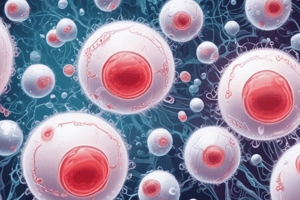Podcast
Questions and Answers
What is the origin of macrophages?
What is the origin of macrophages?
- Bone marrow
- Spleen
- Blood (correct)
- Tissue
Macrophages are involved in phagocytic activity.
Macrophages are involved in phagocytic activity.
True (A)
What is the site of fixed macrophages?
What is the site of fixed macrophages?
Tissue (histiocytes)
Macrophages are involved in the removal of antigens through their __________ activity.
Macrophages are involved in the removal of antigens through their __________ activity.
Match the following cell types with their characteristics:
Match the following cell types with their characteristics:
What is the characteristic of the cytoplasm of a Mast Cell?
What is the characteristic of the cytoplasm of a Mast Cell?
A Mast Cell has a peripheral nucleus.
A Mast Cell has a peripheral nucleus.
What is the name of the staining technique used to identify Mast Cells?
What is the name of the staining technique used to identify Mast Cells?
Mast cells originate from the ______________ cells.
Mast cells originate from the ______________ cells.
Match the following cell types with their characteristics:
Match the following cell types with their characteristics:
What is the primary function of mast cells and basophils in the body?
What is the primary function of mast cells and basophils in the body?
Mast cells are a type of B cell.
Mast cells are a type of B cell.
What is the main function of histamine released by mast cells?
What is the main function of histamine released by mast cells?
Eosinophils are involved in the release of _______________, a chemotactic factor.
Eosinophils are involved in the release of _______________, a chemotactic factor.
Match the following immune cells with their functions:
Match the following immune cells with their functions:
Flashcards are hidden until you start studying
Study Notes
Mast Cells
- Origin: UMC (Undifferentiated Mast Cells)
- Characteristics: large cell with granular, dark basophilic cytoplasm and central rounded pale nucleus
- Staining: metachromatic staining with toluidine blue
- Similarity: similar to basophils
- Function: initiate allergy response
- Release: histamine, leukotrienes, and other chemical mediators
- Effects: smooth muscle contraction, vasodilation
Eosinophils
- Origin: B-Cells (lymphocytes)
- Functions: secrete reticulin, support, phagocytic activity, and antigen presentation
- Anticoagulant: heparin secretion
- Chemotactic factor: attraction to specific sites
Macrophages
- Origin: blood monocyte
- Sites: fixed (tissue histiocytes) and free
- Functions: phagocytic activity, antigen presentation, and tissue repair
Studying That Suits You
Use AI to generate personalized quizzes and flashcards to suit your learning preferences.



